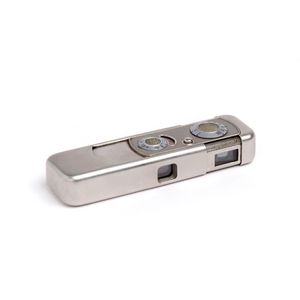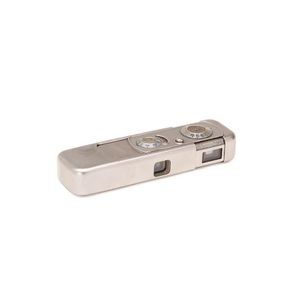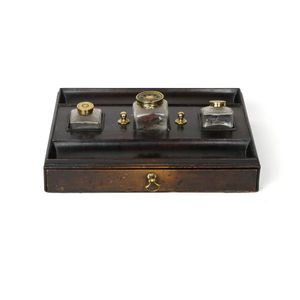Regency Rosewood Standish with Ink Bottles and Drawer
You must be a subscriber, and be logged in to view price and dealer details.
Subscribe Now to view actual auction price for this item
When you subscribe, you have the option of setting the currency in which to display prices to $Au, $US, $NZ or Stg.
- Pounce - Pounce is a finely ground powder made from a mixture of salt, sand, talc, pumice and soapstone. It was used in the era before the invention of blotting paper and was sprinkled over wet ink to speed up the drying process. It was commonly stored in a pounce pot, a container similar to a salt shaker, but with a concave top to allow the unused pounce to be returned to the container. The containers were made wood, silver or ceramic, and were sometimes a component of an inkstand.
- Standish - Although the word is little used nowadays, a standish is an inkstand on feet and usually in silver or silver plate, containing some of the following: inkwells, a pounce pot, a sealing wax container and a pen rest. Standishes are also found in less common materials including boulle, marble, brass and wood.
- Rosewood - A dense timber that varies in shade to very light brown to almost black. When rosewood is cut and sanded the colour of the timber will turn black, and after polishing and exposure to daylight, the surface will gradually lighten over time to light brown with black streaks.
The name comes from the odour emanating from the timber when it is planed, sanded or cut.
Rosewood was very popular for use in Victorian furniture in the second half of the 19th century, and at that time most of the rosewood was imported from Brazil. However it also grows in India and Indonesia.
It is used in the sold for chairs and table legs, but for carcase furniture such as side cabinets and bookcases, and for table tops it is always used as a veneer. - Regency Period - The Regency period in English furniture design refers to the period when King George III, was declared unfit to rule in 1811, and his son ruled as proxy as Prince Regent, until 1820, and then, after the death of his father as George IV until his death in 1830. The Regency period was preceded by the Georgian period (George I, George II, and George III: 1714 - 1811), and was followed by the William IV period, which only lasted until 1837 when William IV died as was succeeded by Queen Victoria.
This item has been included into following indexes:
Visually similar items

Boxed English sterling silver cruet set, hallmarked, Birmingham, 1968, comprising mustard pot, salt, pepper shaker and two spoons

Minox (Riga): Minox sub-miniature camera, 1940 [#10148] engraved 'Made in USSR' in brown leather case with chain.

Minox Vef (Latvia): Minox (original model) sub-miniature camera Sn 14284 c1941-43. With minostigmat 15 mm f3.5 lens. With 'Vef Minox Riga' and 'Made in Latvia' inscribed in base.

